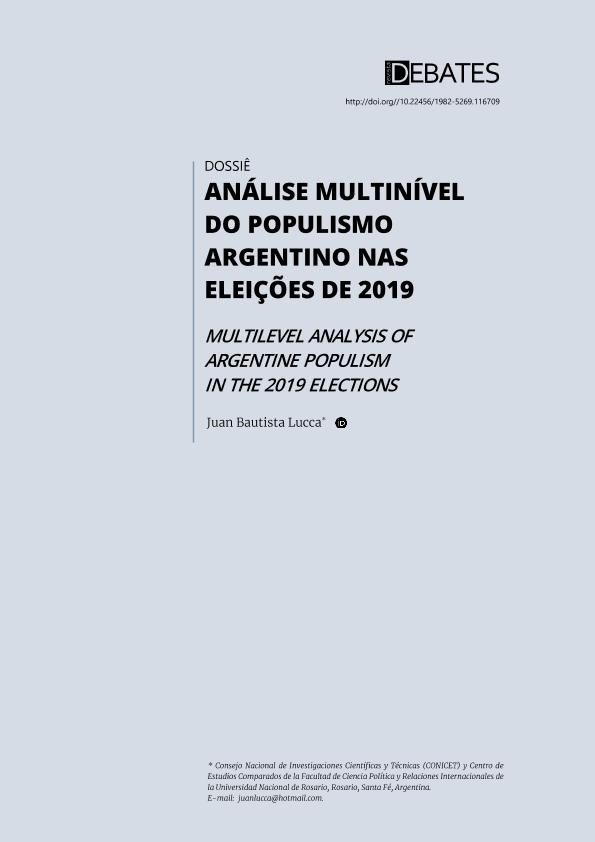Mostrar el registro sencillo del ítem
dc.contributor.author
Lucca, Juan Bautista

dc.date.available
2023-06-29T12:26:15Z
dc.date.issued
2022-04
dc.identifier.citation
Lucca, Juan Bautista; Análise multinível do populismo argentino nas eleições de 2019; Universidade Federal do Rio Grande do Sul; Debates; 16; 1; 4-2022; 96-120
dc.identifier.issn
2236-479X
dc.identifier.uri
http://hdl.handle.net/11336/201783
dc.description.abstract
Nas eleições argentinas de 2019, a disputa política se mostrou polarizada entre a Argentinaperonista de Alberto Fernández e Cristina Fernández de Kirchner, e a nova Argentina deCambiemos, que havia sido inaugurada em 2015 por Mauricio Macri. Ambas as forças seconfiguraram sob uma apelação radical a um fiel eleitorado, ancorado em um discursopopulista que, por um lado, reforçava a figura de seus líderes como os únicos capazes deencontrar o caminho regenerativo diante da crise, e, por outro, mostrava seu adversáriocomo um equívoco político sem futuro. Neste artigo, a lógica do fenômeno populista pode serobservada, em termos territoriais, em ao menos dois itinerários: 1) no eixo horizontal oudentro de uma unidade subnacional; 2) no eixo vertical, no qual a distinção populistanacional transborda sobre a dinâmica provincial. Portanto, observaremos o primeiroitinerário à luz das eleições separadas para governador; e o segundo, nas eleições unificadaspara nação e província.
dc.description.abstract
In the 2019 Argentine elections, the political dispute proved to be polarized between the Peronist Argentina of Alberto Fernández and Cristina Fernández de Kirchner, and the new Argentina of Cambiemos, which was inaugurated in 2015 by Mauricio Macri. Both forces were configured under a radical appeal to a faithful electorate, anchored in a populist discourse that, on the one hand, reinforced the figure of their leaders as the only ones capable of finding the regenerative path in the face of the crisis, and, on the other, showed their opponent as a political mistake with no future. In this paper, the logic of the populist phenomenon can be observed, in territorial terms, in two itineraries: 1) on the horizontal axis or within a subnational unit; 2) on the vertical axis, in which the national populist distinction spills over into the provincial dynamics. Thus, we will look at the first itinerary in light of the separate gubernatorial elections; and the second itinerary in the unified elections for nation and province.
dc.format
application/pdf
dc.language.iso
por
dc.publisher
Universidade Federal do Rio Grande do Sul

dc.rights
info:eu-repo/semantics/openAccess
dc.rights.uri
https://creativecommons.org/licenses/by/2.5/ar/
dc.subject
POPULISMO
dc.subject
ARGENTINA
dc.subject
ELECCIONES
dc.subject
POPULISMO SUBNACIONAL
dc.subject.classification
Ciencia Política

dc.subject.classification
Ciencia Política

dc.subject.classification
CIENCIAS SOCIALES

dc.title
Análise multinível do populismo argentino nas eleições de 2019
dc.type
info:eu-repo/semantics/article
dc.type
info:ar-repo/semantics/artículo
dc.type
info:eu-repo/semantics/publishedVersion
dc.date.updated
2023-06-28T16:53:53Z
dc.identifier.eissn
1982-5269
dc.journal.volume
16
dc.journal.number
1
dc.journal.pagination
96-120
dc.journal.pais
Brasil

dc.journal.ciudad
Porto Alegre
dc.description.fil
Fil: Lucca, Juan Bautista. Universidad Nacional de Rosario. Facultad de Ciencia Política y Relaciones Internacionales; Argentina. Consejo Nacional de Investigaciones Científicas y Técnicas. Centro Científico Tecnológico Conicet - Rosario; Argentina
dc.journal.title
Debates
dc.relation.alternativeid
info:eu-repo/semantics/altIdentifier/url/https://seer.ufrgs.br/index.php/debates/article/view/116709
Archivos asociados
